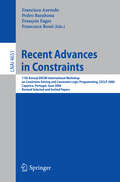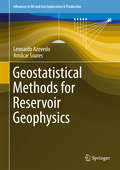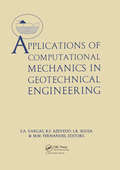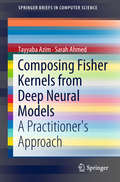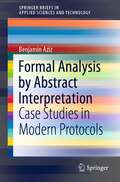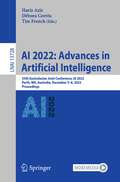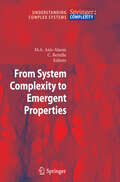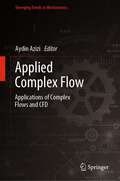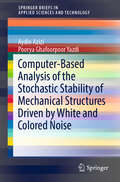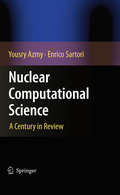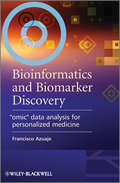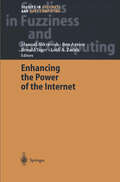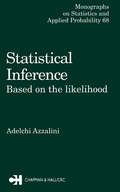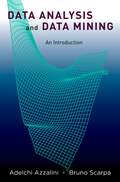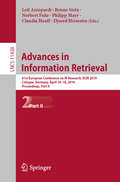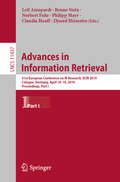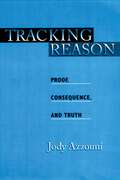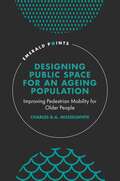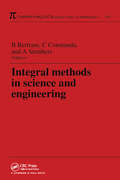- Table View
- List View
Recent Advances in Constraints: 11th Annual ERCIM International Workshop on Constraint Solving and Constraint Logic Programming, CSCLP 2006 Caparica, Portugal, June 26-28, 2006 Revised Selected and Invited Papers (Lecture Notes in Computer Science #4651)
by Francisco Azevedo Pedro Barahona François Fages Francesca RossiThis book constitutes the thoroughly refereed and extended post-proceedings of the 11th Annual ERCIM International Workshop on Constraint Solving and Constraint Logic Programming, CSCLP 2006, held in Caparica, Portugal in June 2006. The papers are organized in topical sections on global constraints, search and heuristics, language and implementation issues, and modeling.
Geostatistical Methods for Reservoir Geophysics (Advances in Oil and Gas Exploration & Production)
by Leonardo Azevedo Amílcar SoaresThis book presents a geostatistical framework for data integration into subsurface Earth modeling. It offers extensive geostatistical background information, including detailed descriptions of the main geostatistical tools traditionally used in Earth related sciences to infer the spatial distribution of a given property of interest. This framework is then directly linked with applications in the oil and gas industry and how it can be used as the basis to simultaneously integrate geophysical data (e.g. seismic reflection data) and well-log data into reservoir modeling and characterization. All of the cutting-edge methodologies presented here are first approached from a theoretical point of view and then supplemented by sample applications from real case studies involving different geological scenarios and different challenges. The book offers a valuable resource for students who are interested in learning more about the fascinating world of geostatistics and reservoir modeling and characterization. It offers them a deeper understanding of the main geostatistical concepts and how geostatistics can be used to achieve better data integration and reservoir modeling.
Applications of Computational Mechanics in Geotechnical Engineering
by R. F. AzevedoThe development of constitutive relations for geotechnical materials, with the help of numerical models, have increased notably the ability to predict and to interpret the mechanical behaviour of geotechnical works. This work covers rock excavations, soil excavations, earth fills and dams.
Composing Fisher Kernels from Deep Neural Models: A Practitioner's Approach (SpringerBriefs in Computer Science)
by Tayyaba Azim Sarah AhmedThis book shows machine learning enthusiasts and practitioners how to get the best of both worlds by deriving Fisher kernels from deep learning models. In addition, the book shares insight on how to store and retrieve large-dimensional Fisher vectors using feature selection and compression techniques. Feature selection and feature compression are two of the most popular off-the-shelf methods for reducing data’s high-dimensional memory footprint and thus making it suitable for large-scale visual retrieval and classification. Kernel methods long remained the de facto standard for solving large-scale object classification tasks using low-level features, until the revival of deep models in 2006. Later, they made a comeback with improved Fisher vectors in 2010. However, their supremacy was always challenged by various versions of deep models, now considered to be the state of the art for solving various machine learning and computer vision tasks. Although the two research paradigms differ significantly, the excellent performance of Fisher kernels on the Image Net large-scale object classification dataset has caught the attention of numerous kernel practitioners, and many have drawn parallels between the two frameworks for improving the empirical performance on benchmark classification tasks. Exploring concrete examples on different data sets, the book compares the computational and statistical aspects of different dimensionality reduction approaches and identifies metrics to show which approach is superior to the other for Fisher vector encodings. It also provides references to some of the most useful resources that could provide practitioners and machine learning enthusiasts a quick start for learning and implementing a variety of deep learning models and kernel functions.
Formal Analysis by Abstract Interpretation: Case Studies in Modern Protocols (SpringerBriefs in Applied Sciences and Technology)
by Benjamin AzizThe book provides a gentle introduction and definition of the denotational-based abstract interpretation method. The book demonstrates how the above method of formal analysis can be used, not only to address the security of systems, but other more general and interesting properties related to the testing, mutating and semantic ambiguity resolution of protocols. The book presents three case studies, all related to current complex protocols and standards used in industry, particularly in the context of IoT and Industry 4.0.
AI 2022: 35th Australasian Joint Conference, AI 2022, Perth, WA, Australia, December 5–8, 2022, Proceedings (Lecture Notes in Computer Science #13728)
by Haris Aziz Débora Corrêa Tim FrenchThis book constitutes the refereed proceedings of the 35th Australasian Joint Conference on Artificial Intelligence, AI 2022, which took place in Perth, WA, Australia, in December 5–8, 2022. The 56 full papers included in this book were carefully reviewed and selected from 90 submissions. They were organized in topical sections as follows: Computer Vision; Deep Learning; Ethical/Explainable AI; Genetic Algorithms; Knowledge Representation and NLP; Machine Learning; Medical AI; Optimization; and Reinforcement Learning.
Emergent Properties in Natural and Artificial Dynamical Systems (Understanding Complex Systems)
by Moulay Aziz-Alaoui Cyrille BertelleAn important part of the science of complexity is the study of emergent properties arising through dynamical processes, in various natural and artificial systems. This book presents multidisciplinary approaches for creating and modeling representations of complex systems, and a variety of methods for extracting emergent structures. Offering bio-complexity examples, the coverage extends to self organization, synchronization, stability and robustness. The contributors include researchers in physics, engineering, biology and chemistry.
From System Complexity to Emergent Properties (Understanding Complex Systems)
by Moulay Aziz-Alaoui Cyrille BertelleEmergence and complexity refer to the appearance of higher-level properties and behaviours of a system that obviously comes from the collective dynamics of that system's components. These properties are not directly deducible from the lower-level motion of that system. Emergent properties are properties of the "whole'' that are not possessed by any of the individual parts making up that whole. Such phenomena exist in various domains and can be described, using complexity concepts and thematic knowledges. This book highlights complexity modelling through dynamical or behavioral systems. The pluridisciplinary purposes, developed along the chapters, are able to design links between a wide-range of fundamental and applicative Sciences. Developing such links - instead of focusing on specific and narrow researches - is characteristic of the Science of Complexity that we try to promote by this contribution.
Applied Complex Flow: Applications of Complex Flows and CFD (Emerging Trends in Mechatronics)
by Aydin AziziThis book presents improved numerical techniques and applied computer-aided simulations as a part of emerging trends in mechatronics in all areas related to complex fluids, with particular focus on using a combination of modeling, theory, and simulation to study systems that are complex due to the rheology of fluids (i.e., ceramic pastes, polymer solutions and melts, colloidal suspensions, emulsions, foams, micro-/nanofluids, etc.) and multiphysics phenomena in which the interactions of various effects (thermal, chemical, electric, magnetic, or mechanical) lead to complex dynamics. The areas of applications span materials processing, manufacturing, and biology.
Industry 4.0: Technologies, Applications, and Challenges (Emerging Trends in Mechatronics)
by Aydin Azizi Reza Vatankhah BarenjiThis book presents Industry 4.0 enabler technologies and tools. It also highlights some of the existing empirical applications in the context of manufacturing. The book elucidates innovative thematic concepts of Industry 4.0 and its perspectives. It establishes routes to empirically utilize Industry 4.0 standards for manufacturing companies. The book can be used as a reference for professionals/engineers, researchers, and students.
Computer-Based Analysis of the Stochastic Stability of Mechanical Structures Driven by White and Colored Noise (SpringerBriefs in Applied Sciences and Technology)
by Aydin Azizi Poorya Ghafoorpoor YazdiThis book provides a concise introduction to the behavior of mechanical structures and testing their stochastic stability under the influence of noise. It explains the physical effects of noise and in particular the concept of Gaussian white noise. In closing, the book explains how to model the effects of noise on mechanical structures, and how to nullify / compensate for it by designing effective controllers.
Nuclear Computational Science: A Century in Review
by Yousry Azmy Enrico SartoriNuclear engineering has undergone extensive progress over the years. In the past century, colossal developments have been made and with specific reference to the mathematical theory and computational science underlying this discipline, advances in areas such as high-order discretization methods, Krylov Methods and Iteration Acceleration have steadily grown. Nuclear Computational Science: A Century in Review addresses these topics and many more; topics which hold special ties to the first half of the century, and topics focused around the unique combination of nuclear engineering, computational science and mathematical theory. Comprising eight chapters, Nuclear Computational Science: A Century in Review incorporates a number of carefully selected issues representing a variety of problems, providing the reader with a wealth of information in both a clear and concise manner. The comprehensive nature of the coverage and the stature of the contributing authors combine to make this a unique landmark publication. Targeting the medium to advanced level academic, this book will appeal to researchers and students with an interest in the progression of mathematical theory and its application to nuclear computational science.
Bioinformatics and Biomarker Discovery: "Omic" Data Analysis for Personalized Medicine
by Francisco AzuajeThis book is designed to introduce biologists, clinicians and computational researchers to fundamental data analysis principles, techniques and tools for supporting the discovery of biomarkers and the implementation of diagnostic/prognostic systems. The focus of the book is on how fundamental statistical and data mining approaches can support biomarker discovery and evaluation, emphasising applications based on different types of "omic" data. The book also discusses design factors, requirements and techniques for disease screening, diagnostic and prognostic applications. Readers are provided with the knowledge needed to assess the requirements, computational approaches and outputs in disease biomarker research. Commentaries from guest experts are also included, containing detailed discussions of methodologies and applications based on specific types of "omic" data, as well as their integration. Covers the main range of data sources currently used for biomarker discovery Covers the main range of data sources currently used for biomarker discovery Puts emphasis on concepts, design principles and methodologies that can be extended or tailored to more specific applications Offers principles and methods for assessing the bioinformatic/biostatistic limitations, strengths and challenges in biomarker discovery studies Discusses systems biology approaches and applications Includes expert chapter commentaries to further discuss relevance of techniques, summarize biological/clinical implications and provide alternative interpretations
Bioinformatics and Biomarker Discovery: "Omic" Data Analysis for Personalized Medicine
by Francisco AzuajeThis book is designed to introduce biologists, clinicians and computational researchers to fundamental data analysis principles, techniques and tools for supporting the discovery of biomarkers and the implementation of diagnostic/prognostic systems. The focus of the book is on how fundamental statistical and data mining approaches can support biomarker discovery and evaluation, emphasising applications based on different types of "omic" data. The book also discusses design factors, requirements and techniques for disease screening, diagnostic and prognostic applications. Readers are provided with the knowledge needed to assess the requirements, computational approaches and outputs in disease biomarker research. Commentaries from guest experts are also included, containing detailed discussions of methodologies and applications based on specific types of "omic" data, as well as their integration. Covers the main range of data sources currently used for biomarker discovery Covers the main range of data sources currently used for biomarker discovery Puts emphasis on concepts, design principles and methodologies that can be extended or tailored to more specific applications Offers principles and methods for assessing the bioinformatic/biostatistic limitations, strengths and challenges in biomarker discovery studies Discusses systems biology approaches and applications Includes expert chapter commentaries to further discuss relevance of techniques, summarize biological/clinical implications and provide alternative interpretations
Enhancing the Power of the Internet (Studies in Fuzziness and Soft Computing #139)
by Ben Azvine Ronald R. Yager Lofti A. Zadeh Masoud NikraveshThis book presents reports from the forefront of soft computing in the Internet industry and covers important topics in the field such as search engines, fuzzy query, decision analysis and support systems as well as e-business and e-commerce.
Statistical Inference Based on the likelihood
by Adelchi AzzaliniThe Likelihood plays a key role in both introducing general notions of statistical theory, and in developing specific methods. This book introduces likelihood-based statistical theory and related methods from a classical viewpoint, and demonstrates how the main body of currently used statistical techniques can be generated from a few key concepts, in particular the likelihood.Focusing on those methods, which have both a solid theoretical background and practical relevance, the author gives formal justification of the methods used and provides numerical examples with real data.
Statistical Inference Based on the likelihood (Monographs On Statistics And Applied Probability #Vol. 68)
by Adelchi AzzaliniThe Likelihood plays a key role in both introducing general notions of statistical theory, and in developing specific methods. This book introduces likelihood-based statistical theory and related methods from a classical viewpoint, and demonstrates how the main body of currently used statistical techniques can be generated from a few key concepts, in particular the likelihood.Focusing on those methods, which have both a solid theoretical background and practical relevance, the author gives formal justification of the methods used and provides numerical examples with real data.
Data Analysis and Data Mining: An Introduction
by Adelchi Azzalini Bruno ScarpaAn introduction to statistical data mining, Data Analysis and Data Mining is both textbook and professional resource. Assuming only a basic knowledge of statistical reasoning, it presents core concepts in data mining and exploratory statistical models to students and professional statisticians-both those working in communications and those working in a technological or scientific capacity-who have a limited knowledge of data mining. This book presents key statistical concepts by way of case studies, giving readers the benefit of learning from real problems and real data. Aided by a diverse range of statistical methods and techniques, readers will move from simple problems to complex problems. Through these case studies, authors Adelchi Azzalini and Bruno Scarpa explain exactly how statistical methods work; rather than relying on the "push the button" philosophy, they demonstrate how to use statistical tools to find the best solution to any given problem. Case studies feature current topics highly relevant to data mining, such web page traffic; the segmentation of customers; selection of customers for direct mail commercial campaigns; fraud detection; and measurements of customer satisfaction. Appropriate for both advanced undergraduate and graduate students, this much-needed book will fill a gap between higher level books, which emphasize technical explanations, and lower level books, which assume no prior knowledge and do not explain the methodology behind the statistical operations.
Data Analysis and Data Mining: An Introduction
by Adelchi Azzalini Bruno ScarpaAn introduction to statistical data mining, Data Analysis and Data Mining is both textbook and professional resource. Assuming only a basic knowledge of statistical reasoning, it presents core concepts in data mining and exploratory statistical models to students and professional statisticians-both those working in communications and those working in a technological or scientific capacity-who have a limited knowledge of data mining. This book presents key statistical concepts by way of case studies, giving readers the benefit of learning from real problems and real data. Aided by a diverse range of statistical methods and techniques, readers will move from simple problems to complex problems. Through these case studies, authors Adelchi Azzalini and Bruno Scarpa explain exactly how statistical methods work; rather than relying on the "push the button" philosophy, they demonstrate how to use statistical tools to find the best solution to any given problem. Case studies feature current topics highly relevant to data mining, such web page traffic; the segmentation of customers; selection of customers for direct mail commercial campaigns; fraud detection; and measurements of customer satisfaction. Appropriate for both advanced undergraduate and graduate students, this much-needed book will fill a gap between higher level books, which emphasize technical explanations, and lower level books, which assume no prior knowledge and do not explain the methodology behind the statistical operations.
Advances in Information Retrieval: 41st European Conference on IR Research, ECIR 2019, Cologne, Germany, April 14–18, 2019, Proceedings, Part II (Lecture Notes in Computer Science #11438)
by Leif Azzopardi Benno Stein Norbert Fuhr Philipp Mayr Claudia Hauff Djoerd HiemstraThis two-volume set LNCS 11437 and 11438 constitutes the refereed proceedings of the 41st European Conference on IR Research, ECIR 2019, held in Cologne, Germany, in April 2019. The 48 full papers presented together with 2 keynote papers, 44 short papers, 8 demonstration papers, 8 invited CLEF papers, 11 doctoral consortium papers, 4 workshop papers, and 4 tutorials were carefully reviewed and selected from 365 submissions. They were organized in topical sections named: Modeling Relations; Classification and Search; Recommender Systems; Graphs; Query Analytics; Representation; Reproducibility (Systems); Reproducibility (Application); Neural IR; Cross Lingual IR; QA and Conversational Search; Topic Modeling; Metrics; Image IR; Short Papers; Demonstration Papers; CLEF Organizers Lab Track; Doctoral Consortium Papers; Workshops; and Tutorials.
Advances in Information Retrieval: 41st European Conference on IR Research, ECIR 2019, Cologne, Germany, April 14–18, 2019, Proceedings, Part I (Lecture Notes in Computer Science #11437)
by Leif Azzopardi Benno Stein Norbert Fuhr Philipp Mayr Claudia Hauff Djoerd HiemstraThis two-volume set LNCS 11437 and 11438 constitutes the refereed proceedings of the 41st European Conference on IR Research, ECIR 2019, held in Cologne, Germany, in April 2019. The 48 full papers presented together with 2 keynote papers, 44 short papers, 8 demonstration papers, 8 invited CLEF papers, 11 doctoral consortium papers, 4 workshop papers, and 4 tutorials were carefully reviewed and selected from 365 submissions. They were organized in topical sections named: Modeling Relations; Classification and Search; Recommender Systems; Graphs; Query Analytics; Representation; Reproducibility (Systems); Reproducibility (Application); Neural IR; Cross Lingual IR; QA and Conversational Search; Topic Modeling; Metrics; Image IR; Short Papers; Demonstration Papers; CLEF Organizers Lab Track; Doctoral Consortium Papers; Workshops; and Tutorials.
Tracking Reason: Proof, Consequence, and Truth
by Jody AzzouniWhen ordinary people--mathematicians among them--take something to follow (deductively) from something else, they are exposing the backbone of our self-ascribed ability to reason. Jody Azzouni investigates the connection between that ordinary notion of consequence and the formal analogues invented by logicians. One claim of the book is that, despite our apparent intuitive grasp of consequence, we do not introspect rules by which we reason, nor do we grasp the scope and range of the domain, as it were, of our reasoning. This point is illustrated with a close analysis of a paradigmatic case of ordinary reasoning: mathematical proof.
Designing Public Space for an Ageing Population: Improving Pedestrian Mobility for Older People (Emerald Points)
by Charles B. A. MusselwhiteDesigning Public Space for an Ageing Population examines the barriers older people face by being a pedestrian in the built environment and demonstrates how to overcome them. Drawing on research carried out across the globe, and framed around Bourdieu's theory of capitals, this book establishes how to overcome restrictions and barriers to mobility including: - Infrastructure capital, such as technology, services, roads, pavements, finance and economics - Social capital, for example friends, family, neighbourhood and community - Cultural capital (norms, expectations, rules, laws) - Individual capital (skills, abilities, resilience, adaptation and desire and willingness to change) The book demonstrates that the public realm must be safe and accessible, but also attractive and desirable to an ageing population. The book includes case studies presenting solutions around CABE's objectives of urban design, notably: safe and accessible space including ease of movement; legible space, including adaptability, diversity and choice and; distinctive and aesthetically pleasing space, including character, continuity and quality.
Designing Public Space for an Ageing Population: Improving Pedestrian Mobility for Older People (Emerald Points)
by Charles B. A. MusselwhiteDesigning Public Space for an Ageing Population examines the barriers older people face by being a pedestrian in the built environment and demonstrates how to overcome them. Drawing on research carried out across the globe, and framed around Bourdieu's theory of capitals, this book establishes how to overcome restrictions and barriers to mobility including: - Infrastructure capital, such as technology, services, roads, pavements, finance and economics - Social capital, for example friends, family, neighbourhood and community - Cultural capital (norms, expectations, rules, laws) - Individual capital (skills, abilities, resilience, adaptation and desire and willingness to change) The book demonstrates that the public realm must be safe and accessible, but also attractive and desirable to an ageing population. The book includes case studies presenting solutions around CABE's objectives of urban design, notably: safe and accessible space including ease of movement; legible space, including adaptability, diversity and choice and; distinctive and aesthetically pleasing space, including character, continuity and quality.
Integral Methods in Science and Engineering (Chapman And Hall/crc Research Notes In Mathematics Ser.)
by B Bertram, C Constanda, and A StruthersBased on proceedings of the International Conference on Integral Methods in Science and Engineering, this collection of papers addresses the solution of mathematical problems by integral methods in conjunction with approximation schemes from various physical domains. Topics and applications include: wavelet expansions, reaction-diffusion systems, variational methods , fracture theory, boundary value problems at resonance, micromechanics, fluid mechanics, combustion problems, nonlinear problems, elasticity theory, and plates and shells.
